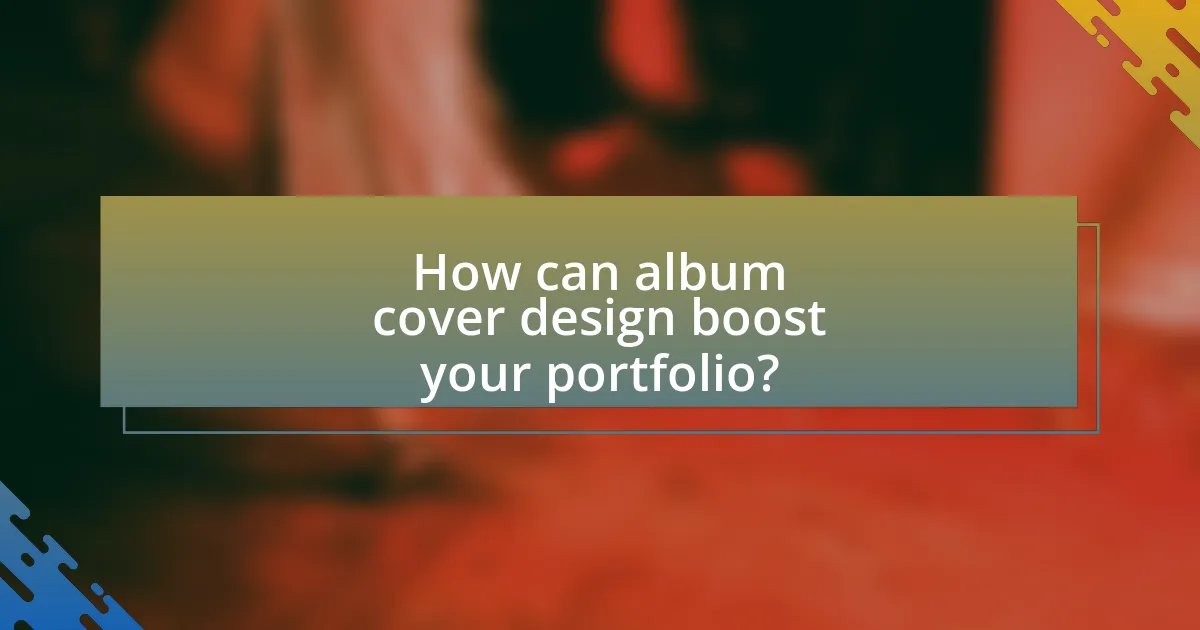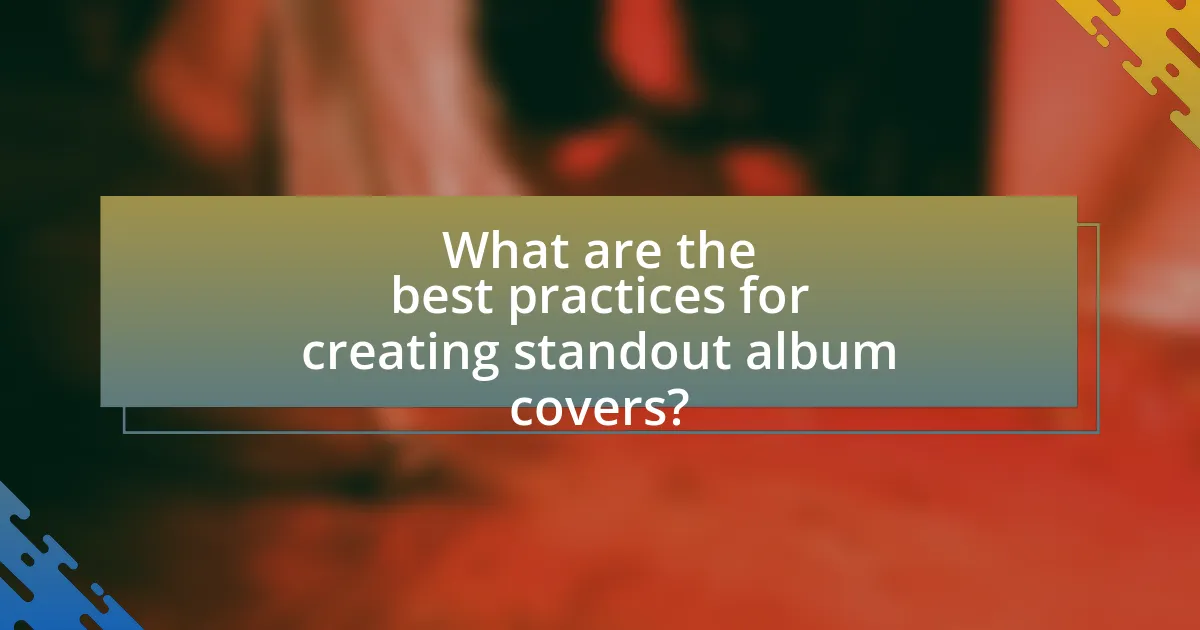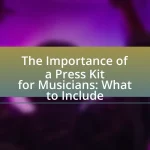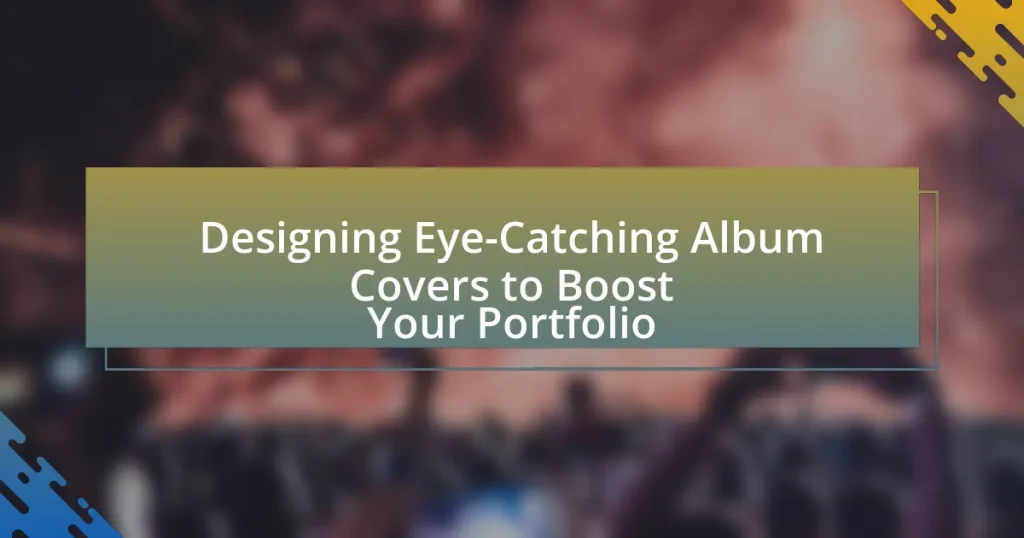The article focuses on the essential elements of designing eye-catching album covers, emphasizing the importance of visual imagery, color theory, typography, and cohesive concepts that resonate with specific music genres. It explores how color combinations can enhance visual appeal and evoke emotions, while typography plays a crucial role in conveying the artist’s identity and the album’s mood. Additionally, the article discusses best practices for creating standout designs, the significance of understanding the target audience, and the technical skills required for effective album cover design. By highlighting these factors, the article aims to demonstrate how well-crafted album covers can boost a designer’s portfolio and attract potential clients.

What are the key elements of designing eye-catching album covers?
The key elements of designing eye-catching album covers include strong visual imagery, effective use of color, typography, and a clear concept that reflects the music genre. Strong visual imagery captures attention and conveys the album’s theme, while effective color choices evoke emotions and set the mood. Typography must be legible and stylistically aligned with the music, enhancing the overall aesthetic. A clear concept ensures that the design resonates with the target audience, making it memorable. Research indicates that album covers with cohesive design elements significantly increase consumer interest and sales, highlighting the importance of these factors in successful album cover design.
How does color theory influence album cover design?
Color theory significantly influences album cover design by guiding the selection of colors that evoke specific emotions and convey the music’s genre. Designers utilize color psychology, where warm colors like red and orange can create feelings of excitement or passion, while cool colors like blue and green can evoke calmness or introspection. For instance, the album cover for “Blue” by Joni Mitchell employs blue tones to reflect themes of melancholy and introspection, aligning with the album’s emotional content. This strategic use of color not only enhances visual appeal but also strengthens the connection between the artwork and the music, making it more memorable and impactful for the audience.
What emotions do different colors evoke in album cover design?
Different colors evoke specific emotions in album cover design, influencing the viewer’s perception and connection to the music. For instance, red often conveys passion and energy, making it suitable for genres like rock or pop. Blue typically evokes feelings of calmness and introspection, aligning well with genres such as jazz or blues. Yellow is associated with happiness and optimism, often used in upbeat or cheerful music covers. Green symbolizes nature and tranquility, making it a good fit for folk or acoustic genres. Black can represent sophistication or mystery, frequently seen in electronic or alternative music. These associations are supported by color psychology research, which indicates that colors can significantly impact emotional responses and consumer behavior.
How can color combinations enhance visual appeal?
Color combinations enhance visual appeal by creating contrast, harmony, and emotional resonance in design. Effective color pairings can draw attention, evoke specific feelings, and establish a cohesive aesthetic. For instance, complementary colors, such as blue and orange, create a striking contrast that can make elements stand out, while analogous colors, like blue and green, promote a sense of unity and calmness. Research indicates that color influences perception; a study published in the journal “Color Research and Application” found that color combinations significantly affect viewer preferences and emotional responses. Thus, strategic use of color combinations is essential in designing visually appealing album covers that attract and engage audiences.
What role does typography play in album cover design?
Typography plays a crucial role in album cover design by conveying the artist’s identity and the album’s mood. Effective typography enhances visual appeal, ensuring that the text is legible and complements the overall design. For instance, the choice of font style, size, and color can evoke specific emotions and attract the target audience. Historical examples include the bold, sans-serif fonts used in punk rock album covers, which reflect the genre’s rebellious spirit. Additionally, research indicates that well-designed typography can significantly influence consumer perception and purchasing decisions, making it a vital element in creating memorable album covers.
How do font choices affect the perception of music genres?
Font choices significantly influence the perception of music genres by conveying specific emotions and cultural associations. For instance, bold and angular fonts often evoke feelings of energy and aggression, aligning well with genres like rock or electronic music, while softer, rounded fonts may suggest calmness and intimacy, which are more suitable for genres like jazz or acoustic. Research indicates that visual elements, including typography, can shape listeners’ expectations and interpretations of music, as demonstrated in studies where participants associated certain fonts with specific genres, reinforcing the idea that design elements play a crucial role in genre identification and marketing.
What are the best practices for typography in album covers?
The best practices for typography in album covers include selecting legible fonts, ensuring contrast between text and background, and maintaining a cohesive style that reflects the music genre. Legible fonts enhance readability, especially at smaller sizes, while high contrast ensures that the text stands out, making it easily identifiable. Additionally, a cohesive style aligns the typography with the overall aesthetic of the album, which is crucial for attracting the target audience. Research indicates that effective typography can significantly influence consumer perception and engagement, making it a vital element in album cover design.
Why is imagery important in album cover design?
Imagery is crucial in album cover design because it visually represents the music and conveys the artist’s identity. Effective imagery captures the essence of the album’s themes, emotions, and genre, making it instantly recognizable to potential listeners. For instance, iconic album covers like The Beatles’ “Sgt. Pepper’s Lonely Hearts Club Band” utilize vibrant colors and surreal elements to reflect the psychedelic music of the era, enhancing the listener’s experience and connection to the album. This visual representation not only attracts attention but also communicates the artistic vision, making it a vital component in marketing and branding within the music industry.
What types of images resonate with different audiences?
Different audiences resonate with various types of images based on their demographics, interests, and cultural backgrounds. For instance, younger audiences often respond well to vibrant, bold colors and contemporary designs that reflect current trends, while older audiences may prefer classic, understated visuals that evoke nostalgia. Research indicates that images featuring people, particularly those expressing emotions, tend to engage viewers more effectively across demographics, as they create a sense of connection and relatability. Additionally, specific genres of music influence image preferences; for example, album covers for electronic music often utilize abstract designs, while folk music covers may feature natural landscapes or intimate portraits.
How can imagery convey the artist’s message or theme?
Imagery can convey the artist’s message or theme by visually representing concepts, emotions, and narratives that resonate with the audience. For instance, a dark color palette and abstract shapes in an album cover can evoke feelings of melancholy or introspection, aligning with the themes of the music. Research indicates that visual elements significantly influence emotional responses; a study published in the Journal of Experimental Psychology found that images can enhance the interpretation of music by providing context and emotional cues. Therefore, effective imagery not only complements the music but also deepens the listener’s understanding of the artist’s intended message.

How can album cover design boost your portfolio?
Album cover design can significantly boost your portfolio by showcasing your creativity and technical skills in a visually impactful way. A well-designed album cover serves as a tangible representation of your artistic vision, attracting potential clients and collaborators. According to a survey by the Graphic Artists Guild, 70% of clients prioritize visual appeal when selecting a designer, indicating that striking album covers can lead to increased job opportunities. Additionally, featuring diverse styles and genres in your portfolio demonstrates versatility, making you more appealing to a broader range of clients in the music industry.
What skills can be showcased through album cover design?
Album cover design showcases skills in graphic design, typography, illustration, and branding. Graphic design skills are evident in the composition, color theory, and visual hierarchy used to create appealing covers. Typography skills are highlighted through the selection and arrangement of fonts that convey the album’s mood and genre. Illustration skills can be showcased through original artwork or creative adaptations that enhance the visual narrative. Additionally, branding skills are demonstrated by aligning the album cover with the artist’s identity and target audience, ensuring consistency across promotional materials. These skills collectively contribute to a designer’s portfolio, illustrating their versatility and creativity in visual communication.
How does album cover design demonstrate creativity and originality?
Album cover design demonstrates creativity and originality through the unique visual representation of an artist’s music and identity. Each cover serves as a canvas for artistic expression, often incorporating innovative techniques, styles, and concepts that reflect the genre and themes of the album. For instance, iconic covers like The Beatles’ “Sgt. Pepper’s Lonely Hearts Club Band” showcase a blend of photography, illustration, and vibrant colors, which not only capture attention but also convey the essence of the music. This originality is further evidenced by the use of diverse materials and formats, such as hand-drawn illustrations or digital art, allowing designers to push boundaries and create memorable imagery that resonates with audiences.
What technical skills are highlighted in album cover projects?
Album cover projects highlight several technical skills, including graphic design, typography, illustration, and digital editing. Graphic design skills are essential for creating visually appealing layouts that capture the essence of the music. Typography is crucial for selecting fonts that convey the album’s mood and style effectively. Illustration skills may be employed to create unique artwork that stands out. Digital editing skills, particularly in software like Adobe Photoshop and Illustrator, are necessary for manipulating images and ensuring high-quality output. These skills collectively contribute to the creation of compelling album covers that enhance an artist’s visual identity.
Why is a strong portfolio important for designers?
A strong portfolio is crucial for designers because it serves as a visual representation of their skills and creativity. This collection of work showcases a designer’s unique style, technical abilities, and versatility, making it essential for attracting potential clients and employers. Research indicates that 85% of hiring managers consider a portfolio to be the most important factor when evaluating candidates in creative fields. A well-curated portfolio not only highlights completed projects but also demonstrates a designer’s problem-solving capabilities and thought process, which are vital in the competitive design industry.
How does a well-designed album cover attract potential clients?
A well-designed album cover attracts potential clients by visually communicating the essence of the music and the artist’s brand. This visual representation captures attention and evokes emotions, making it more likely for potential listeners to engage with the album. Research indicates that 90% of snap judgments made about products are based on color alone, highlighting the importance of design elements in influencing consumer behavior. Additionally, a striking album cover can enhance the perceived value of the music, leading to increased sales and streaming.
What impact does a diverse portfolio have on career opportunities?
A diverse portfolio significantly enhances career opportunities by showcasing a range of skills and adaptability to potential employers. This variety demonstrates creativity and versatility, which are highly valued in competitive fields such as design and marketing. Research indicates that candidates with diverse portfolios are 50% more likely to be shortlisted for interviews, as they can appeal to a broader audience and meet various client needs. Additionally, a diverse portfolio can lead to increased networking opportunities, as it reflects an individual’s ability to collaborate across different styles and projects, further expanding professional connections.

What are the best practices for creating standout album covers?
The best practices for creating standout album covers include using bold visuals, maintaining a cohesive theme, and ensuring high-quality imagery. Bold visuals capture attention and can convey the album’s mood or genre effectively; for instance, iconic covers like Pink Floyd’s “The Dark Side of the Moon” utilize striking imagery to create a memorable impact. A cohesive theme ties the cover art to the music, enhancing the listener’s experience; for example, the artwork of The Beatles’ “Sgt. Pepper’s Lonely Hearts Club Band” reflects the eclectic nature of the album. High-quality imagery is essential, as pixelated or poorly designed covers can detract from the music’s perceived value; research shows that professional design increases consumer interest and sales.
How can you effectively research and understand your target audience?
To effectively research and understand your target audience, utilize a combination of surveys, interviews, and social media analytics. Surveys can gather quantitative data on preferences, while interviews provide qualitative insights into motivations and behaviors. Social media analytics tools, such as Facebook Insights or Instagram Analytics, reveal demographic information and engagement patterns. According to a 2021 study by HubSpot, 70% of marketers prioritize understanding their audience’s needs to enhance their strategies, demonstrating the importance of this research in creating appealing album covers that resonate with potential listeners.
What methods can be used to gather audience insights for design?
Surveys and interviews are effective methods to gather audience insights for design. Surveys allow designers to collect quantitative data on preferences, while interviews provide qualitative insights into audience motivations and emotions. According to a study by the Nielsen Norman Group, user interviews can reveal critical insights that surveys may overlook, making them complementary tools in understanding audience needs.
How does audience understanding influence design choices?
Audience understanding significantly influences design choices by ensuring that the visual elements resonate with the target demographic. Designers who grasp the preferences, cultural references, and emotional triggers of their audience can create album covers that effectively communicate the intended message and evoke the desired response. For instance, research indicates that album covers appealing to specific age groups often incorporate relevant color schemes and imagery that align with the cultural context of that demographic, enhancing engagement and marketability. This alignment between audience insights and design decisions ultimately leads to more successful visual communication and a stronger connection with potential listeners.
What tools and software are essential for album cover design?
Essential tools and software for album cover design include Adobe Photoshop, Adobe Illustrator, and Canva. Adobe Photoshop is widely used for its powerful image editing capabilities, allowing designers to manipulate photos and create intricate designs. Adobe Illustrator is essential for vector graphics, enabling the creation of scalable artwork that maintains quality at any size. Canva offers a user-friendly interface with templates, making it accessible for those who may not have advanced design skills. These tools are industry standards, widely recognized for their effectiveness in producing professional-quality album covers.
Which design software is most popular among professionals?
Adobe Photoshop is the most popular design software among professionals. It is widely used in the graphic design industry for its extensive features that allow for detailed image editing and manipulation. According to a survey conducted by Creative Bloq in 2023, over 70% of professional designers reported using Adobe Photoshop as their primary tool for creating visual content, including album covers. This high adoption rate underscores its dominance and reliability in professional design workflows.
How can online resources enhance your design skills?
Online resources can significantly enhance design skills by providing access to a wide range of tutorials, design tools, and community feedback. These resources, such as platforms like Skillshare and Coursera, offer structured courses that cover essential design principles and software skills, enabling learners to improve their technical abilities. Additionally, websites like Behance and Dribbble allow designers to showcase their work and receive constructive criticism from peers, fostering growth and innovation. Research indicates that 70% of learners feel more confident in their skills after utilizing online educational platforms, demonstrating the effectiveness of these resources in skill enhancement.
What tips can help you create memorable album covers?
To create memorable album covers, focus on a strong visual concept that reflects the music’s theme and genre. A compelling design often incorporates unique typography, striking imagery, and a cohesive color palette that resonates with the target audience. For instance, iconic album covers like Pink Floyd’s “The Dark Side of the Moon” utilize simple yet powerful graphics that convey complex themes, making them instantly recognizable. Additionally, consider the use of symbolism and storytelling elements to engage viewers on a deeper level, as seen in The Beatles’ “Sgt. Pepper’s Lonely Hearts Club Band,” which invites interpretation and discussion.
How can you incorporate feedback into your design process?
Incorporating feedback into your design process involves actively seeking and integrating input from peers, clients, and target audiences. Designers can implement structured feedback sessions, such as critiques or surveys, to gather diverse perspectives on their work. Research indicates that iterative design, which includes regular feedback loops, enhances creativity and leads to more effective outcomes, as seen in studies by the Nielsen Norman Group, which emphasize the importance of user-centered design. By analyzing this feedback and making informed adjustments, designers can refine their album cover designs to better resonate with their audience, ultimately boosting their portfolio’s appeal.
What common mistakes should be avoided in album cover design?
Common mistakes to avoid in album cover design include poor typography, lack of visual hierarchy, and overcomplicating the design. Poor typography can detract from the overall message and aesthetic, as legibility is crucial for effective communication. A lack of visual hierarchy may confuse viewers, making it difficult to identify the main elements of the cover. Overcomplicating the design can lead to clutter, which distracts from the music and the artist’s identity. These mistakes can diminish the impact of the album cover, ultimately affecting its marketability and reception.















